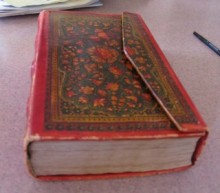By Laura Berenger and Milan Bobysud
Recently I had the pleasure of viewing and repairing a beautiful antique Persian Quran. Each delicate page was beautifully hand-written, and the traditional Islamic leather cover with foredge flap was decorated with intricately painted flowers and vines. The multi-colored floral panels combined with the vibrant red borders make for a bold, yet delicately styled book. Several pages at the front and rear of the textbook were loose, and the interior and exterior hinges required some repair. In keeping with the client’s priority that the least invasive approach be taken, the loose pages and hinges were secured using Japanese tissue. The tissue used for the outer hinges was tinted to make the repair as inconspicuous as possible. The minimally invasive repairs succeeded in strengthening the original pieces of this lovely book so that it may be carefully handled without further damage to either the text block or the covers. A particularly distinctive feature of the traditional Islamic style of binding is that the foredge flap rests under the front cover, not over it.
~Laura Berenger, Bookbinder and Conservator
(Above) Pre-Treatment: Close up of Damage
This simple, but structurally stable and fully supportive pedestal is made to museum standards using only archivally sound, high-quality materials: 100% rag museum board, framing linen and PVA adhesive. Its structure is specifically designed to give the antique Quran solid support without straining any of the potentially fragile binding joints, and to allow for an eye-pleasing and revealing display of all the intricate details of this precious volume.
~Milan Bobysud, Associate Conservator of Custom Framing and Fabrication
(Above) Post Treatment: Detail
(Above) Post Treatment





